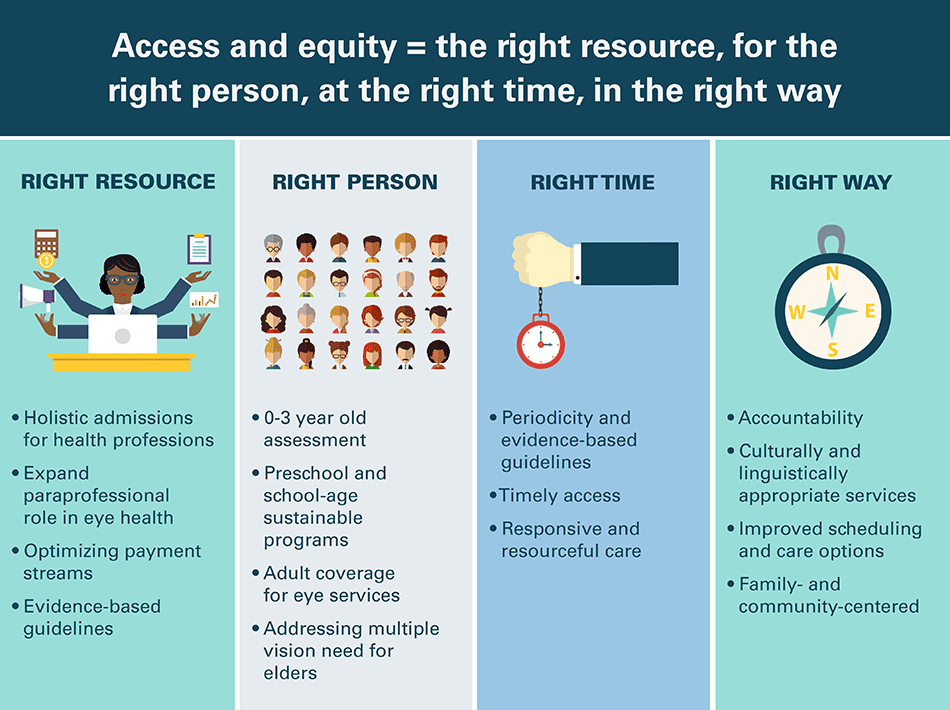It is the mission of the Center for Vision and Population Health (CVPH) to convene and empower key stakeholders to recognize and integrate vision and eye health as an important driver of health and quality of life.
The goal of the CVPH is to raise awareness of vision and eye health as a fundamental driver of quality of life and to ensure all health allies are empowered to fully integrate vision and eye health into population health agendas. The CVPH works toward this goal by serving as a national technical assistance and policy resource for advancing vision and eye health from the population health perspective. The Center was conceived to carry out the critical role as a convener of national experts on vision health, research, patient perspectives, and public health while collaborating with community, state, and national stakeholders. The CVPH works across multiple fronts, including advocacy, education, program interventions, and more, to protect vision, eliminate inequities, and mitigate the impact of the social determinants of health that disproportionately burden certain populations, causing increased risk for vision loss. It must also be responsive to emerging topics that impact vision and eye health.
The Center for Vision and Population Health works across multiple fronts, including advocacy, education, program outreach, and more, to protect vision. The information, resources, and guidance developed by the CVPH will result in increased awareness about eye health and preventive practices that can be utilized at all levels to maintain healthy vision for life. Key approaches to improve vision and eye health include:
- Conducting an assessment of existing multi-stakeholder groups and establishing a communication sharing plan
- Implementing local, state, and national education campaigns
- Leveraging diverse national data sources, prevalence data, and research
- Promoting vision and eye health
- Identifying and disseminating existing or emerging toolkits/best practices/research
- Collaborating with partners
- Addressing key research and surveillance gaps
- Reviewing existing and needed accountability measures or policies
The following five subcommittees were established to help advance the mission of CVPH:
Stakeholder Assessment and Awareness
(Chair: Marc Molea, AICP)
Best Practices/Resource Dissemination
(Co-Chairs: Chris Maylahn, MPH, DrPH & Nita Patel Sinha, OD, MPH)
Leveraging Data and Surveillance Sources
(Co-Chairs: Joshua Ehrlich, MD, MPH & Xinzhi Zhang, MD, PhD, FACE, FRSM)
Publishing and Presenting
(Chair: Dean VanNasdale, OD, MS, PhD)
Accountability Measures
(Chair: Peter Jacobson, JD, MPH)
Vision Health Equity and Communications Task Force Roster (pdf)
Goal of the Vision Health Equity Task Force:
The goal of the Vision Health Equity Task Force is to ensure that all activities and decisions within the CVPH are mindful of the intersectionality of structural racism and health and how implicit and explicit bias contributes to poor outcomes. Our goal is to improve vision health care outcomes and the mechanisms are to reduce racism and biases.
The strength of The Center for Vision and Population Health lies in its capacity to convene stakeholders across multiple academic institutions, local and state governments, private nonprofits, industry, and consumers to respond with agility and integrity to address public health and vision problems relevant to the lives of people with or at risk of vision impairment. By drawing together the best minds in the country, the Center will identify critical gaps in vision and public health and create strategies to respond to them while ensuring new perspectives are brought to bear, and an interest in vision and eye health will continue to spread.
Initially, the Center is convening an Executive Planning Committee to ensuring the right mix of advisors are engaged, priorities for the Center are clearly established, and that the scope of priorities is focused. Subsequent to this work, a core group of targeted multi-disciplinary experts will be identified to serve as the Center’s Advisory Committee. Rather than act as advocates for specific organizations, Advisory Committee and workgroup members will be asked to represent their individual perspectives and leverage their professional experiences while being guided by scientific evidence leading toward a group consensus approach.
The committee’s primary role will be to identify a limited number of critical topics with the greatest potential to affect vision and eye health at the population level. The Advisory Committee will leverage data from improved surveillance efforts – including state and national survey data – as well as peer-reviewed scientific literature to identify areas of geographic, population, and disease significance that provide opportunity for significant impact.
Advisory committee members
(Co-Chair) Joshua R. Ehrlich, MD, MPH
(Co-Chair) Susan Primo, OD, MPH, FAAO
Mitchell V. Brinks, MD, MPH
Angela R. Elam, MD
Devina Kuo Fan, MPH
Kevin Frick, PhD
Peter D. Jacobson, JD, MPH
Edwin C. Marshall, OD, MS, MPH
Chris Maylahn, MPH, DrPH
Nancy D. Miller, LMSW
Marcus J. Molea, AICP, MHA
David B. Rein, PhD, MPA
Jinan Saaddine, MD, MPH
Joan Stelmack, OD, MPH
Dean VanNasdale, OD, MS, PhD\
Xinzhi Zhang, MD, PhD, FACE, FRSM
Staff
Jeff Todd, President and CEO
Julie Grutzmacher, Director of Patient Advocacy and Population Health Initiatives
Kira Baldonado, Vice President, Public Health and Policy
Nita Patel Sinha, Director of Public Health
Heather Patrick, President and CEO, Prevent Blindness Texas
These institutions, organizations and corporations make the work of the Center for Vision and Population Health possible.
Centers for Disease Control and Prevention-Vision Health Initiative
National Association of Chronic Disease Directors
Healthy vision can be a key component to independence and well-being for people of all ages. However barriers such as poor access to eye care, lack of insurance coverage, and inconsistent policies for eye health can prevent early detection and treatment of eye disorders. Prevent Blindness is committed to convening stakeholders in vision, public health, and patient advocacy to address the barriers to healthy vision and work to increase the uniformity of vision preservation nationally. To accomplish this, the Center for Vision and Population Health at Prevent Blindness (CVPH) has been established as a national coordinating body for effective practices, state-level technical assistance, and programmatic interventions.

In 2016, the National Academies of Sciences, Engineering, and Medicine (NASEM) published the landmark report Making Eye Health a Population Health Imperative: Vision for Tomorrow, defining vision and eye health problems as a growing public health concern for the nation. It proposed nine recommendations to improve vision and health equity in the United States.
Prevent Blindness, in partnership with the National Association of Chronic Disease Directors (NACDD), convened a follow-up meeting of stakeholders to assess the feasibility of establishing a national technical assistance resource center for vision and eye health to advance the recommendation of the report and to generally elevate vision and public health as a national priority
Through this process, the Center was conceived to carry out the critical role as a convener of national experts on eye care, vision, and public health. It will collaborate with community, state, and national stakeholders. It will support state-level programs by delivering technical support and evidence-based interventions. While the Center’s activities will draw guidance from the NASEM report, it will also be responsive to emerging topics to sustain a population health approach to vision and eye health.
The Center will advance seven core functions:
- Support ongoing surveillance efforts, including the use of predictive analytics to determine the likelihood of future outcomes, and contribute to enhanced understanding of incidence, prevalence, and trend data about vision and eye health.
- Establish and strengthen a national multi-sector network of partner organizations for the purpose of increasing information sharing and collaboration, reducing redundancies, and coordinating projects and initiatives
- Create an online vision and public health toolkit to guide state program and policy development, and could include a variety of content, such as flagship programs that could serve as models and a foundation for peer-to-peer mentoring across states. The toolkit would be continually updated with the emergence of new evidence-based best practices.
- Integrate and expand early detection initiatives (including both vision screenings and eye examinations) across diverse clinical and non-clinical settings, including but not limited to community health centers, public health programs, primary health care settings, adult and senior health programs, minority health programs, early intervention, and educational programs.
- Expand vision and eye health education to include health care professionals, allied health care providers, community health workers, and age-specific networks.
- Identify and disseminate evidence-based interventions to promote vision and eye health, prevent injuries, and reduce inequities in vision and eye health.
- Explore the integration of vision and eye health interventions into broader chronic care models, whether through public health departments on health care systems; evaluating the design, cost, and impact of such programs.

Specifically, the Center will advance the seven core functions identified above by:
- Identifying and convening key thought leaders in vision and public health to advance critical emerging issues identified in the NASEM report (including social determinants of eye and vision health; evidence-based, population risk, and protective factors; access and utilization; comorbid conditions; innovative interventions; systems changes; emerging vision threats; etc.), and to publish topical papers aimed at providing guidance and/or recommending strategies to promote public health activities documented to reduce vision problems.
- Collaborating with other stakeholders to ensure public health systems are inclusive of vision and eye health and to advance community-level responses to vision and eye health needs as opportunities arise to advance collective objectives.
- Serving as a national technical assistance resource to support state and community initiatives by educating stakeholders about the importance of vision and eye health, providing expertise to incorporate vision and eye health into existing programs and policies, developing and disseminating materials to support community best practice and evidence-based collaborations, and promoting partnerships among community sectors.
- Hosting the annual Focus on Eye Health National Summit as a key venue to disseminate and discuss emerging research in vision and public health. This Summit, currently hosted by Prevent Blindness, will serve as a strong platform to bring existing and new stakeholders to the table to support and disseminate innovation in vision and eye health, as well as to continually promote the NASEM report and monitor national progress in reaching its goals.
Founded in 1908, Prevent Blindness works to improve the nation’s vision and eye health by promoting advances in public health systems of care that support eye health needs, by advocating for public policies that emphasize early detection and access to eye care, by educating the American public on the importance of taking care of their eyes and their vision, and by advancing initiatives that ensure those living with vision loss are able to sustain a high quality of life. This work primarily focuses around ages and populations at highest risk and is supported and enhanced by a network of affiliates, regional offices, and other program partners. Prevent Blindness is deeply committed to working with states and stakeholders in diverse ways to develop comprehensive and sustainable vision and eye health programs via a consensus-based approach. By establishing the Center for Vision and Population Health at Prevent Blindness, a permanent home is in place to ensure an ongoing, coordinated effort for the advancement of vision in public health in the United States.


